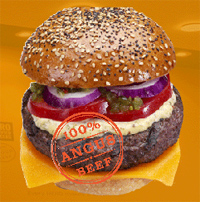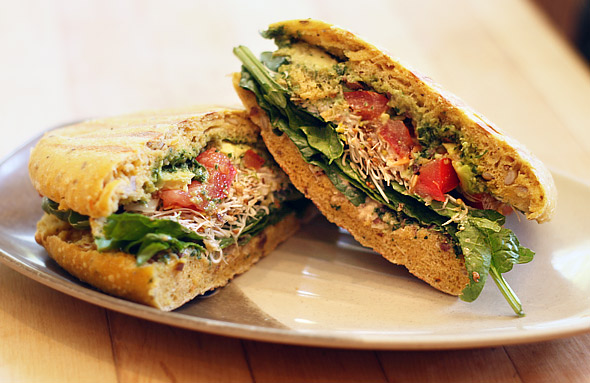I spend so much time writing about the sorts of sandwiches that I like, and why I like them, that I was encouraged to write a post on things that I don’t like. On popular sandwiches or sandwich constructs that I think are bad sandwich form. I have found the process of thinking about this quite difficult. There is very little that I don’t like to eat across the whole of food, let alone within specialised realm of sandwiches. Going beyond that to think about why some of these popular sandwiches are actually bad sandwiches, rather than just reflecting my personal disgust has also been hard. Here are my top four:
Baguette sandwiches
 |
| A Terrible Place |
In case you haven’t noticed, baguettes are all crust. When presented with a sliced bread sandwich, people will often leave the crusts on their plate (sometimes for fear of getting the curly hair that my mother promised me if I ate them). Other people will cut the crusts off, or you can now buy crust-free bread. I think that this is because the crust is generally accepted as the toughest and least flavoursome part of a sandwich.
Why then would you take that oft-discarded morsel and use it as the basis for a whole sandwich? Don’t get me wrong, I like a crusty ciabatta burger bun occasionally, I enjoy the odd dinner roll, and I love garlic baguettes, but there is something about baguette crust that is particularly un-suited to sandwiches. It tends to be very thick, sharp so it attacks the roof of your mouth, and then endlessly chewy. I have experienced the most intense jaw-ache whilst trying to eat a baguette sandwich. And it’s because it’s impossible to break up the crust-fest. Once presented with a baguette sandwich, there is no way to slice it or attack it that does not involve taking 360 degrees of crust with every bite. I would much rather take out all of the filling, slice the baguette, and make a little impromptu crostini. Unfortunately this is not acceptable behaviour in polite company.
Steak Sandwiches
 |
| Worst nightmare |
I have a similar problem with steak sandwiches, particularly cold steak sandwiches. Steak is difficult to cut through cleanly in one bite, especially rare steak, and doubly so for cold, rare steak. Unless you only dine on prime cuts of fillet (or filet mignon in Canada) then you’re in for a toothsome time. My experience with cold steak sandwiches is of one big, hearty bite, fantastic flavours, and then a chewing conundrum. Do I keep trying to cut cleanly through this meat so that I can pull away from this sandwich with a cleanly captured bite? Or do I cut my losses and just try and rip it whilst I pull away? Invariably the former results in a long bout of fruitless chewing and attempts to isolate individual meat fibres to bite through and release my mouthful. The latter usually takes most of the sandwich filling with it, leading to all of the steak from the sandwich hanging down your face, rather than nestled comfortably between the slices of bread where it belongs. There is a reason that you get a special knife when you order a ribeye at your local restaurant, and I’m afraid my teeth just aren’t serrated. The cold steak sandwich is a bad way to use leftover steak.
Open-faced sandwiches.
Enough said.
No but really, the contradiction within the phrase says it all. It starts with a basic misunderstanding of what the sandwich is, and ends with a pretentious name is wildly inaccurate.
When the term ‘sandwich’ came into popular use, it was because John Montagu, 4th Earl of Sandwich wanted meat between two slices of bread. And there wasn’t a name for that at the time. It was the perfect food - he could eat it with one hand whilst playing cribbage and not get his cards dirty. None of these things are true of the open-faced sandwich. You can’t eat it with one hand unless you want to make a mess, it doesn’t involve two slices of bread and there is already a name for it – ‘on bread’ or ‘on toast’ or even ‘crostini’ or ‘bruschetta’ if you’re feeling continental.
Let me give you a little of the history of the open-faced sandwich (by history I mean “what Wikipedia says” so appropriate scepticism applies):
“During the Middle Ages, thick slabs of coarse and usually stale bread, called "trenchers", were used as plates. After a meal, the food-soaked trencher was fed to a dog, less fortunate beggars, or eaten by the diner. Trenchers were as much the harbingers of open-face sandwiches as they were of disposable dishware.”
Fed to the dogs and beggars – is that what you want for dinner? And it has the audacity to claim kinship with the 4th Earl of Sandwich? Ridiculous.
Finally, something that I know will upset people:
Veal Parmesan Sandwiches.
Or, more broadly, and breaded sandwich filling. By that I mean wienerschnitzel, breaded aubergine, even fish fingers.
I know that veal parmesan sandwiches are very popular in Toronto. A guy that I work with has tried them all over the city and can rattle off his top 5 on demand, and tell you what is different about each one. And I agree to some extent. The combination of flavours is fantastic and there area wide variety of approaches to this Italian-Canadian staple.
However, they all start with breaded, deep fried veal and this is something that I have a problem with. In many ways this comes down to texture again. I don’t see what the breading adds to the sandwich. On a plate, breaded veal would be slightly crispy on the outside and soft in the centre. A perfect contrast of textures. But in a sandwich, with sauce on it, the breading becomes mushy breadcrumbs and adds this soggy, grainy texture to the sandwich. If anything, I think the breading takes away from the sandwich. I understand that it adds some flavour, in the form of seasoning or parmesan within the crumbing but you could add these flavours without the breading. The only way that the breading would serve its textural purpose (i.e. to add crunch) would be if the sandwich was completely dry. And that wouldn’t be nice either.
It also seems unnecessarily fatty. I’m not a person who shies away from fatty food, or eats low fat alternatives in general, but if there is NO TASTE DIFFERENCE between a higher fat and a lower fat option (example: baked salted tortilla chips) I will take the lower fat option. In this case, I think that pan frying the veal actually makes more sense texturally and it’s lower fat. Win-win.
The other problem that I have is that it’s already in bread because it’s in a sandwich (unless it’s open faced obviously) – why do you need extra bread? And why can’t the bread of the sandwich serve the purpose of the veal breading? It can be crunchy, it can take on flavours, you can even deep fry it if you want to. Bread within bread seems like an odd redundancy.
Three out of four of these complaints are related to texture and I realise that texture is very important to me – perhaps more so than to others. As someone who has no strong dislikes of any food, I think it only natural that my dislikes point in a textural direction. A recent poll of my friends’ sandwich complaints yielded quite a mixed set of results, with some denouncing specific ingredients, some questioning textures, and one pointing to the ordering of the ingredients within the sandwich as the most important issue. Whilst there is no ultimate decree about what makes a sandwich good or bad, I would like to think that my complaints are something that you can identify with and might influence your sandwich choices in the future


![[UK+106.jpg]](https://blogger.googleusercontent.com/img/b/R29vZ2xl/AVvXsEgAaW7zFYMxxn6x0ojyYFUonANoBpw-Zk2z1pk6Q_psocWqlIbE_-bxqGYO0CquqAxsav-VkN1Wq5QSEueebnnJEbru4SSeahX4i2wO6mlyCXNh79UxWVR7d0QT08C_MlG7-2kd5W82_f0/s400/UK+106.jpg)




